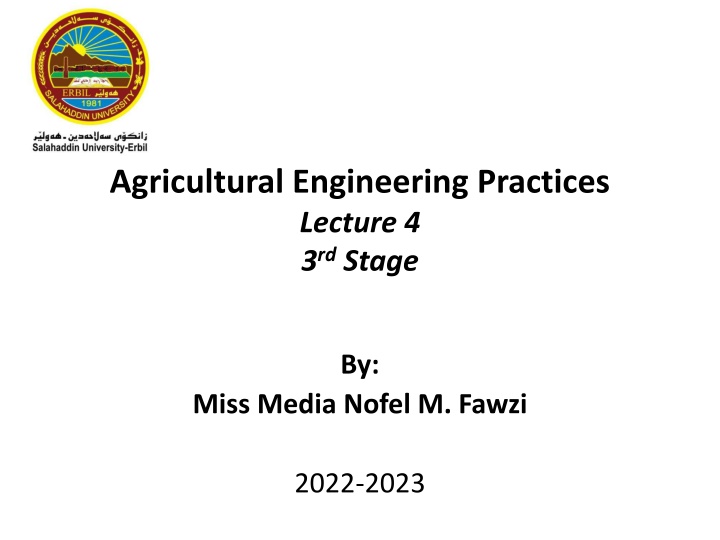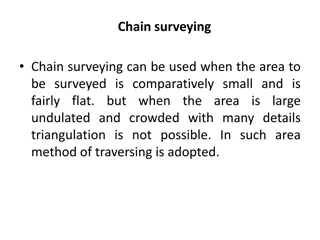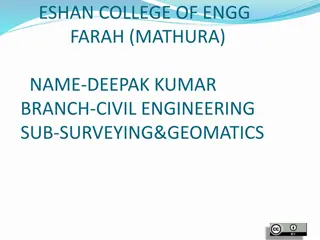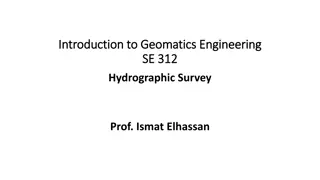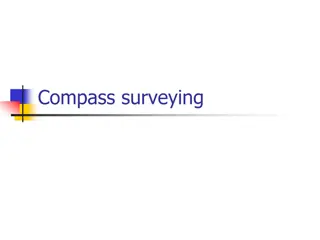Agricultural Engineering Practices - Surveying Techniques and Equipment
Explore the types of surveying techniques and equipment used in agricultural engineering practices, including chain surveying and leveling. Learn about water levels, optical levels, and how to use a water level in the field for accurate measurements.
Download Presentation

Please find below an Image/Link to download the presentation.
The content on the website is provided AS IS for your information and personal use only. It may not be sold, licensed, or shared on other websites without obtaining consent from the author.If you encounter any issues during the download, it is possible that the publisher has removed the file from their server.
You are allowed to download the files provided on this website for personal or commercial use, subject to the condition that they are used lawfully. All files are the property of their respective owners.
The content on the website is provided AS IS for your information and personal use only. It may not be sold, licensed, or shared on other websites without obtaining consent from the author.
E N D
Presentation Transcript
Agricultural Engineering Practices Lecture 4 3rdStage By: Miss Media Nofel M. Fawzi 2022-2023
Outline of presentation: Types of surveying and equipment. Types of levels. Using a water level on the field. Survey accuracy.
Types of surveying and equipment 1. Chain surveying: In a chain survey, the area to be surveyed is enclosed by one or more triangles whose sides are measured and recorded. Then the perpendicular distance from the side of a triangle to each point of detail such as trees, buildings, boundaries, etc. is measured. Figure 7-7: The survey chain
Types of surveying and equipment 2.Leveling: Leveling is a survey procedure that determines the relative heights of points on the earth s surface. The telescope of an optical level, or laser beam on a laser system, provides a horizontal line of collimation or line of sight.
Types of levels The three different types of levels used for most agricultural surveying work are water levels, optical levels and laser levels. a. Water levels: Water levels are an effective way of measuring different elevations over relatively short distances. Importantly, care must be taken to make sure that air bubbles do not get trapped in the line. Water levels are very easy and cheap to make but require an operator at both ends. Figure 7-8: Using a water level on the field
Types of levels Using a water level on the field: 1.Fill a clear plastic water pipe with water. 2.Make sure that there are no bubbles trapped in the hose. 3.Start the process by placing the staff or measuring pole at one point in the field. 4.Move only one end at a time and record the height at both ends of the hose. 5.The change in height is calculated by recording the difference in height between each station. 6. This operation requires two people to perform and is relatively slow.
Types of levels b.Optical levels: Automatic optical levels are now readily available, relatively cheap and reduce operator error. Optical surveying requires two people: one person to hold the staff and the other to operate the level. Builder s optical levels, which are readily available, are not applicable for agricultural surveying. Figure 7-9: Using a water level on the field
Types of levels Most of the surveying work done in an agricultural situation does not require highly sophisticated or expensive optical equipment. The features required in an agricultural type level are: Easy to change the permanent adjustment as required An upright image that makes reading the staff easier An ability to read the staff at 150 meters in poor conditions A standard deviation over 1 kilometer of no more than 3 millimeters Damping of the compensator to prevent fluttering in the wind A magnification between 26 and 32 times
Types of levels Figure 7-10: Leveling field experience
Types of levels c. Laser levels: Laser levels are now widely used for surveying purposes in the construction industry. They are very simple to use and readily available in most countries. Recordings can often be taken in a radius of 300 meters from the transmitter. Laser levels can be operated by one person. Figure 7-11: Laser levels
Types of levels Benefits of laser levels. The benefits over other land leveling methods include the following: More level and smooth soil surface Reduction in time and water required to irrigate the field More uniform distribution of water in the field More uniform moisture environment for crops More uniform germination and growth of crops Reduction in seeds, fertilizer, chemicals and fuel used in cultural cooperation Improved field traffic ability (for subsequent operations)
Types of levels d. Surveyor leveling instrument: The surveyor level is an instrument that establishes a line of sight that is nearly perpendicular to gravity at the instrument and maintains this angle without change in whatever direction it is pointed. At equal distances from the instrument the line of sight marks the position of a certain level surface. Figure 7-16: Leveling equipment
Survey accuracy To check the accuracy of a survey, the survey must be closed. A survey is closed by completing new set-ups and readings, until we return to the first point surveyed. It will be impossible for the first reading and the last reading taken during the survey to be identical. The level of variation will depend on the equipment being used and the skill of the operator.
